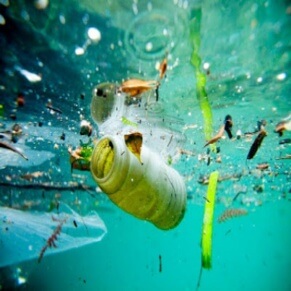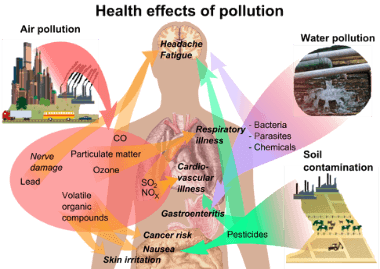Definition of Water PollutionWater is a crucial natural resource that is thought to be absolutely necessary for maintaining all types of life in the biosphere. As a result, the security of the water supply has been a major factor in determining how human settlements are distributed across the surface of the world. Since rivers are the main source of fresh water, most people have chosen to reside along their banks. Before the industrial revolution, it was feasible to successfully extract and consume water from water bodies. But circumstances have changed, and during the past few decades, the majority of the world's nations have had to contend with a massive rise in the human population, accelerating urbanisation, and unending industrialization. In streams, lakes, tanks, ponds, springs, huge reservoirs, and shallow and deep wells, rainfall is the primary supply of water. These bodies of water produce rainwater, but the pollutants and greater amounts of certain chemicals they carry in their rainwater have a variety of negative impacts on human health. Any unpleasant substance that is not naturally present in water, such as microbes, chemicals, garbage, or sewage, enters the water and renders it unfit for its intended use. 
Water pollution is the contamination of water sources by contaminants that render the water unfit for drinking, cooking, cleaning, swimming, and other uses. Chemicals, garbage, bacteria, and parasites are all examples of pollutants. Additionally, water pollution may consist of chemicals introduced into the water bodies as a result of various human activities. Any amount of those chemicals pollute the water, regardless of the harm they may pose to human health and the environment. All types of pollutants eventually end up in the water. Lakes and oceans are affected by air pollution. Land pollution may contaminate an underground stream, a river, and ultimately the ocean. As a result, rubbish thrown in an empty lot can eventually contaminate a water source. Water pollution-related terms1. Concentration The concentration of a chemical in water. Part per Million (PPM) is the technical term for the ratio of 1 drop of chemical to 1,000,000 droplets of water. This is equivalent to one drop of water in a bathtub. Part per Billion (PPB) is equivalent to one chemical drop in a swimming pool worth of water. 2. Effluent Chemicals or other industrial waste that is released into the environment. 3. Eutrophication In lakes and ponds, plants and very small creatures grow so quickly that they exhaust all of the oxygen in the water, suffocating everything else. It is brought on by the water having too many nutrients. 4. Filtration Pushing water through objects with incredibly small holes to remove debris and microscopic organisms. 5. Nutrients Substances, such as farmland fertilisers and sewage, that are used as nourishment by plants and animals. Eutrophication is a result of excess nutrients in the water. 6. Sewage The typically biologically contaminated effluent from companies and restrooms. 7. Toxic When a chemical exerts hazardous effects quickly, this is known as acute toxicity (hours to days). Chronic toxicity results when an organism is exposed to a chemical over a prolonged period of time in low doses. Years may pass before the toxic effects manifest, frequently as a disease like cancer. 8. Watershed A region which contains all the water systems (rivers, lakes, reservoirs, subterranean water sources, etc.) created by the runoff of rain and snow from the land, streets, and mountains in a certain region. In the end, the water empties into the ocean. CausesNumerous regularly used chlorinated solvents in the industry (including PCE, TCE, and 1,1,1-TCA) are examples of such compounds that contaminate our water exclusively as a result of human activity. Another illustration is MTBE (Methyl-tert-butyl-ether), an oxygenate of gasoline that is currently prohibited in the United States. The term "water pollutants" is used to refer to any chemicals or biological agents that cause water pollution, regardless of whence they originated. Water pollutants are generally used to refer to the chemical and biological agents that are the primary sources of water contamination. No matter its size or location, every type of water can become contaminated. Due to the airborne transmission of pollution particles and their transfer into precipitation water, this includes lakes from remote places or large water bodies. Swimming pools, ponds, lakes, streams, rivers, seas, and oceans are all examples of surface and groundwater, all of which have the potential to eventually become contaminated. The larger the water body, the quicker the time it takes for the pollution to be naturally cleaned up and recovered due to the rapid diffusion and dissipation of contaminants and the speedier natural degradation processes. Types of water pollutantsOn the basis of the numerous causes of water pollution, there are various forms of pollution. Depending on the many causes of water contamination, different classifications can be made. The type of water pollutants according to this classification standard, water pollution can be: 1. ChemicalThis type of water contamination is brought on by different chemicals. The most typical water contaminants include the following chemicals: (1) Petroleum products, including crude oil (including gasoline, diesel fuel, kerosene, motor and lubricating oils, and jet fuel). Being lighter than water, these substances always float on top of the water, leaving behind "free product" sheens. But some of these substances dissolve in water and may be dangerous even in trace amounts, undetectable to the naked eye. (2) Fertilizers (including nitrates and phosphates): While tiny amounts are necessary for life, bigger concentrations in water only benefit algae and dangerous microbes while poisoning humans and aquatic life. Since they don't create sheens or colour the water, these contaminants cannot be observed in water by themselves, but their impacts can be seen. The rapid and abundant expansion of aquatic life is a typical result of fertilizer-related water contamination (which typically occurs through agricultural runoff). (3) Chlorinated solvents are hazardous and highly persistent, sink in water (since they are denser than water), and include TCE, PCE, 1,1,1-TCA, carbon tetrachloride, and Freons. As a result, these substances are invisible to the naked eye, unlike petroleum products, which are plainly visible as sheens on the surface of the water. Petroleum-based solvents (such as benzene, toluene, xylenes, and ethylbenzene) Other organic solvents and chemicals (such as acetone, methyl ethyl ketone, alcohols such as ethanol, and isopropanol; or oxygenate compounds such as MTBE) antibiotics and other medicinal goods; (4) Perchlorate: Perchlorate salts are used in many different products, including fireworks, explosives, road flares, inflation bags, etc. Military bases and construction areas are typically connected with this pollutant (when explosives are used). Perchlorate in water may, however, also be due to natural production in arid regions (e.g., in Chile, Texas or California where the natural formation of perchlorate has been observed). Trihalomethanes are typical results of water chlorination, and they can contaminate groundwater and surface water through leaking sewer lines and discharges. Among them are dichlorobromomethane, chloroform, and bromoform. (5) Metal and Compounds: Organo-metal complexes, which can develop when metals from water react with organic substances from water, are of greater health danger than metals and their compounds. Hg, As, and Cr poisoning of water are typical examples. So the health risk is increased if water is contaminated with both metals and organic substances. Likewise, marine life is negatively impacted by water pollution. (6) The term "pesticides," which refers to a class of chemicals that include insecticides and herbicides, is used to describe substances that are applied to large areas of land for agricultural purposes either directly or indirectly through runoff. A common illustration of this kind of water pollution is the chemical DDT. (7) Even though PCBs have just been banned, these toxins are frequently linked to urban runoff due to their pervasive environmental presence. 2. RadiologicalWhen radioactive elements are the cause of water pollution. 3. BiologicalWhen the causes of water pollution include different microorganisms (such as bacterial species and viruses), worms, and/or algae that occur in huge numbers. Animal faeces, rotting organic matter in water, inappropriate human waste disposal, and other factors all contribute to this sort of pollution. Grouping of the source of water pollutants:
Examples of water pollutantsThe primary causes of pollution are the improper disposal of chemical waste from industry, home, and medical waste, the disorganised application of agricultural fertilisers, and unintentional oil spills that severely contaminate water. The following are a few examples of significant water pollutants that harm people's health:
Examples of significant water contaminants that only harm the ecology include the following: Sewage, manure, oxygen-demanding manures and agricultural waste were produced by sewage and agricultural run-offs, soil sediments (silt) as a result of soil erosion, and heated fluids used in various industries and power plants. Affect of water pollution on humansThe health of people is seriously harmed by water contamination, which can lead to a wide range of illnesses. This is mostly because we may be exposed to contaminated water in a variety of ways, including, but not exclusively: 
Diseases due to water pollutionPollutants in water have the potential to be toxic or sickening. Insufficiently handled sewage may contain bacteria and parasites that can get into drinking water supplies and cause diarrhoea and cholera. Hazardous substances, such as pesticides, herbicides, and chemicals, are used in homes, farms, businesses, and golf courses. They can have acute toxicity, which can result in instant death, or chronic toxicity, which can cause neurological issues or cancer. When we use water for drinking and cooking, a lot of water pollutants get into our bodies. The gastrointestinal tract receives the contaminants. They can then spread to other bodily organs and lead to a number of diseases. Skin irritations can result from chemicals that come into touch with the skin while washing clothing or swimming in dirty water. The animals and plants that reside there can be impacted by hazardous chemicals in water systems. Sometimes, these organisms will continue to exist with the toxins still in their bodies, only to be eaten by people who may then get slightly ill or have more severe toxic effects. The actual animals and plants could perish or have improper reproduction. What can be done to reduce water pollution?
Next TopicElement Definition
|
 For Videos Join Our Youtube Channel: Join Now
For Videos Join Our Youtube Channel: Join Now
Feedback
- Send your Feedback to [email protected]
Help Others, Please Share










